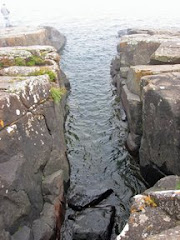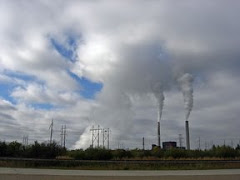Brita Belli
bbelli@emagazine.com
Dear Brita Belli, Editor;
(Please note; I am responding to the article below.)
The Editors of E/Environmental Magazine, in responding to a writer from New York about what the military is doing to "reduce its carbon footprint" fails to mention that this carbon footprint is a heck of a lot bigger than what military operations alone entail.
We have the entire military-financial-industrial complex which includes everything from mining to manufacturing in order to keep the U.S. military machine in operation.
As an example for starters---
It is estimated that between 30% to 60% of all the iron ore mined on Minnesota's Iron Range has gone into military production for everything from tanks to bridges and trucks. Not only does the mining leave a massive carbon footprint but the processing of this iron ore into steel leaves a huge carbon footprint. The manufacturing operations turning this steel into tanks, guns, trucks, bombs leaves another huge carbon footprint and we haven't even begun to consider the enormous quantity of power required to run all of this... one more huge carbon footprint.
The real carbon footprint of the U.S. military entails a lot more than simply how the military uses finished products and engages in untold waste and its contribution to pollution.
Learning to live in peace with our neighbors we share this planet with while "turning swords into plowshares" makes a lot of environmental sense. I wonder how it was that Al Gore and so many environmentalists missed this?
Alan L. Maki
58891 County Road 13
Warroad, Minnesota 56763
Phone: 218-386-2432
Cell Phone: 651-587-5541
E-mail: amaki000@centurytel.net
EarthTalk®
From the Editors of E/The Environmental Magazine
Dear EarthTalk: What is the U.S. military doing to reduce its carbon footprint and generally green its operations? -- Anthony Gomez, New York, NY
As the world’s largest polluter, the U.S. military has its work cut out for it when it comes to greening its operations. According to the nonprofit watchdog group, Project Censored, American forces generate some 750,000 tons of toxic waste annually—more than the five largest U.S. chemical companies combined. Although this pollution occurs globally on U.S. bases in dozens of countries, there are tens of thousands of toxic “hot spots” on some 8,500 military properties right here on America soil.
“Not only is the military emitting toxic material directly into the air and water,” reports Project Censored, “it’s poisoning the land of nearby communities, resulting in increased rates of cancer, kidney disease, increasing birth defects, low birth weight and miscarriage.” The non-profit Military Toxics Project is working with the U.S. government to identify problem sites and educate neighbors about the risks.
Meanwhile, the U.S. military manages 25 million acres of land that provides habitat for some 300 threatened or endangered species. The military has harmed endangered animal populations by bomb tests (and been sued for it), reports Project Censored, and military testing of low-frequency underwater sonar technology has been implicated in the stranding deaths of whales worldwide. Despite being linked to such problems, the U.S. Department of Defense (DoD) has repeatedly sought exemptions from Congress for compliance with federal laws including the Migratory Bird Treaties Act, the Wildlife Act, the Endangered Species Act, the Clean Air Act and the National Environmental Policy Act.
It’s unclear whether the U.S. military is taking heed of criticisms in regard to pollution and endangered species management, but it is undoubtedly concerned about climate change, as its effects on the environment could lead to unprecedented natural resource wars and mass migrations of people. And reducing our reliance on potentially hostile foreign oil sources is a short term national security imperative as well. A recent Obama administration directive calls for the DoD to draw 20 percent of its power from renewable sources by 2020. Nikihl Sonnad of the GreenFuelSpot website reports that the Army and Air Force are planning to include solar arrays on several bases in sunny western states. The Air Force is also building the nation’s largest biomass energy plants in Florida and Georgia, and the Navy is building three large geothermal energy plants and funding research into extracting energy from ocean waves.
Some of the military’s R&D into renewables is for battlefield applications. Outfitting troops with the capability to produce their own on-site power from solar and wind sources not only makes sourcing oil less of a necessity but also should serve to reduce casualties from fuel transport operations. Over 1,000 American troops have lost their lives delivering fuel in the past few years alone (in part because enemy combatants often use fuel trucks as attack targets), says Sonnad.
Elisabeth Rosenthal reports in The New York Times that “there is great hope that some of the renewable energy technology being developed for battle will double back and play a role in civilian life.” She adds that the armed forces have enough purchasing power to create genuine markets in the non-military world.
CONTACTS: Project Censored, www.projectcensored.org; U.S. DoD, www.defense.gov; Military Toxics Project, www.stopmilitarytoxics.org/about.html; GreenFuelSpot, www.greenfuelspot.com.
SEND YOUR ENVIRONMENTAL QUESTIONS TO: EarthTalk®, c/o E – The Environmental Magazine, P.O. Box 5098, Westport, CT 06881; earthtalk@emagazine.com. E is a nonprofit publication. Subscribe: www.emagazine.com/subscribe; Request a Free Trial Issue: www.emagazine.com/trial.
Alan L. Maki
58891 County Road 13
Warroad, Minnesota 56763
Phone: 218-386-2432
Cell Phone: 651-587-5541
E-mail: amaki000@centurytel.net
Check out my Blog:
http://thepodunkblog.blogspot.com/











































































































